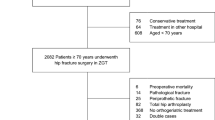Abstract
Background and aims: Hip fracture in older people is an event associated with a high incidence of morbidity and mortality. In this study we compared the clinical outcomes of two groups of orthogeriatric patients in an orthogeriatric care (OC) programme. The OC course, developed into the GeriatricWard, starts from the Emergency Department (OC-1, n=174) or from the Orthopaedic Department after surgery (OC-2, n=87). Methods: For this purpose, OC patients were prospectively enrolled from March 2007 to June 2009, following OC criteria. Door-to-bed time, time to surgery, mobilisation time, length of stay, and post-operative complications were compared between the OC groups. Results: OC-1 patients differ from OC-2 ones only for residence at admission (14.4% vs 4.6% lived in nursing homes, p=0.02). Concerning outcomes, in the OC-1 group only mobilization time was significantly lower (p=0.01). No differences were observed in post-operative complications. Conclusions: In frail older people, hip fracture co-management, with the geriatrician as primary attendant, leads to satisfying outcomes. The OC-1 and OC-2 courses exhibit similar clinical results. An improvement in several organisational aspects, including coordination between hospital and rehabilitation services, is warranted.
Similar content being viewed by others
References
Wiktirowicz ME, Goeree R, Papaioannou A et al. Economic implications of hip fracture: Health service use, institutional care and cost in Canada. Osteoporos Int 2001; 12: 271–8.
Morris AH, Zuckerman JD. National consensus conference on improving the continuum of care for patients with hip fracture. J Bone Joint Surg Am 2002; 84A: 670–4.
Zuckerman JD. Hip fracture. N Engl J Med 1996; 334: 1519–25.
Cummings SR, Rubin SM, Black D. The future of hip fractures in the United States. Number, costs, and potential effects of postmenopausal estrogen. Clin Orthop Relat Res 1990; 252: 163–6.
Piscitelli P, Iolascon G, Gimigliano F et al. Incidence and costs of hip fractures compared to acute myocardial infarction in the Italian population: a 4-year survey. Osteoporos Int 2007; 18: 211–9.
Braithwaite RS, Col NF, Wong JB. Estimating hip fracture morbidity, mortality and costs. J Am Geriatr Soc 2003; 51: 364–70.
Leibson CL, Tosteson AN, Gabriel SE et al. Mortality, disability, and nursing home use for persons with and without hip fracture: a population-based study. J Am Geriatr Soc 2002; 50: 1644–50.
Magaziner J, Hawkes W, Hebel JR. Recovery from hip fracture in eight areas of function. J Gerontol A Biol Sci Med Sci 2000; 55: M498–507.
Adunsky A, Arad M, Levi R. Five-year experience with the ‘Sheba’ model of comprehensive orthogeriatric care for elderly hip fracture patients. Disabil Rehabil 2005; 27: 1123–7.
Friedman SM, Mendelson DA, Kates SL, McCann RM. Geriatric Co-management of proximal femur fractures: total quality management and protocol-driven care result in better outcomes for a frail patient population. J Am Geriatr Soc 2008; 56: 1349–56.
Antonelli Incalzi R, Gemma A, Capparella O. Orthogeriatric Unit: a thinking process and a working model. Aging Clin Exp Res 2008; 20: 109–12.
Charlson ME, Pompei P et al. A new method of classifying prognostic comorbidity in longitudinal studies: development and validation. J Chron Dis 1987; 40: 373–83.
Katz TF. A.D.L. Activities of Daily Living. JAMA 1963; 185: 914–9.
Lawton MP, Brody EM. Assessment of older people: self-maintaining and instrumental activities of daily living. Gerontologist 1969; 9: 179–86.
American Psychiatric Association. Diagnostic and Statistical Manual of Mental Disorders, ed 4, Text Revision, Washington, American Psychiatric Association, 2000.
Folstein MF, Folstein SE, McHugh PR. “Mini-mental state”. A practical method for grading the cognitive state of patients for the clinician. J Psychiatr Res 1975; 12: 189–98.
World Health Organization. The ICD-10 classification of mental and behavioral disorders: diagnostic criteria for research. Geneva, World Health Organization, 1993.
Inouye SK, van Dyck CH, Alessi CA et al. Clarifying confusion: the Confusion Assessment Method: a new method for detection of delirium. Ann Intern Med 1990; 113: 941–8.
Dennison E, Mohamed MA, Cooper C. Epidemiology of osteoporosis. Rheum Dis Clin North Am 2006; 32: 617–29.
Federal Interagency Forum on Aging-Related Statistics. 2008 Older Americans: key indicators of well-being. http://www.agingstats.gov/agingstatsdotnet.
Todd CJ, Freeman CJ, Camilleri-Ferrante C. Differences in mortality after fracture of hip: the East Anglian audit. BMJ 1995; 310: 904–8.
Forsen L, Soogard AJ, Meyer HE. Survival after hip fracture: short- and long-term excess mortality according to age and gender. Osteoporos Int 1999; 10: 73–8.
SIGN: Scottish Intercollegiate Guidelines Network. www.sign.co.uk
Vidán M, Serra JA, Moreno C, Riquelme G, Ortiz J. Efficacy of a comprehensive geriatric intervention in older patients hospitalized for hip fracture: a randomized, controlled trial. J Am Geriatr Soc 2005; 53: 1476–82.
Pioli G, Giusti A, Barone A. Orthogeriatric care for the elderly with hip fractures: where are we? Aging Clin Exp Res 2008; 20: 113–22.
Bottle A, Aylin P. Mortality associated with delay in operation after hip fracture: observational study. BMJ 2006; 332: 947–51.
Al-Ani AN, Samuelsson B, Tidermark J, Norling et al. Early operation on patients with hip fracture improved the ability to return to independent living. J Bone Joint Surg Am 2008; 90: 1436–42.
Friedman SM, Mendelson DA, Bingham RN, Kates SL. Impact of a comanaged Geriatric Fracture Center on short-term hip fracture outcomes. Arch Intern Med 2009; 169: 1712–7.
Sharma G, Kuo YF, Freeman J, Zhang DD, Goodwin JS. Comanagement of hospitalized surgical patients by Medicine Physicians in the United States. Arch Intern Med 2010; 170: 363–8.
Author information
Authors and Affiliations
Corresponding author
Rights and permissions
About this article
Cite this article
Mazzola, P., De Filippi, F., Castoldi, G. et al. A comparison between two co-managed geriatric programmes for hip fractured elderly patients. Aging Clin Exp Res 23, 431–436 (2011). https://doi.org/10.1007/BF03337767
Received:
Accepted:
Published:
Issue Date:
DOI: https://doi.org/10.1007/BF03337767




